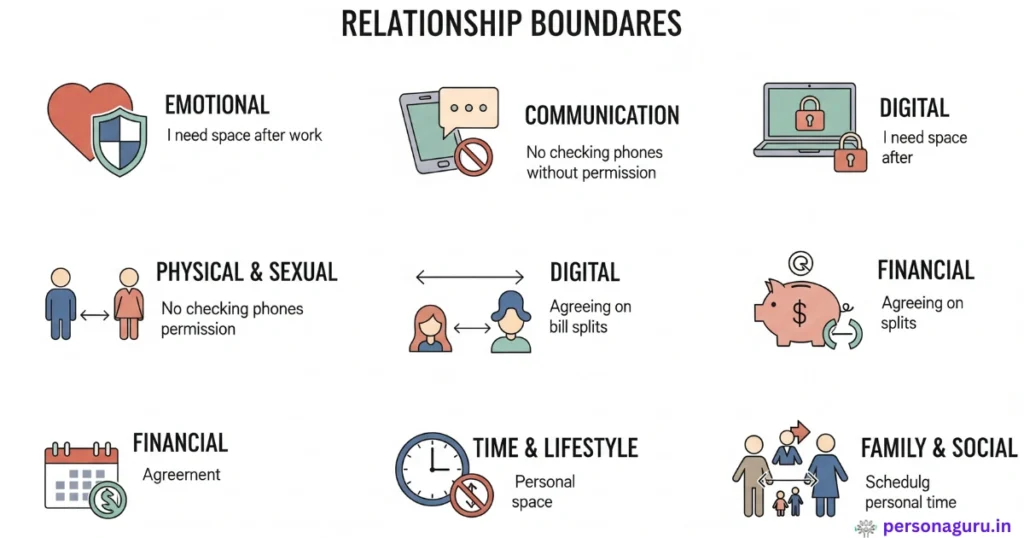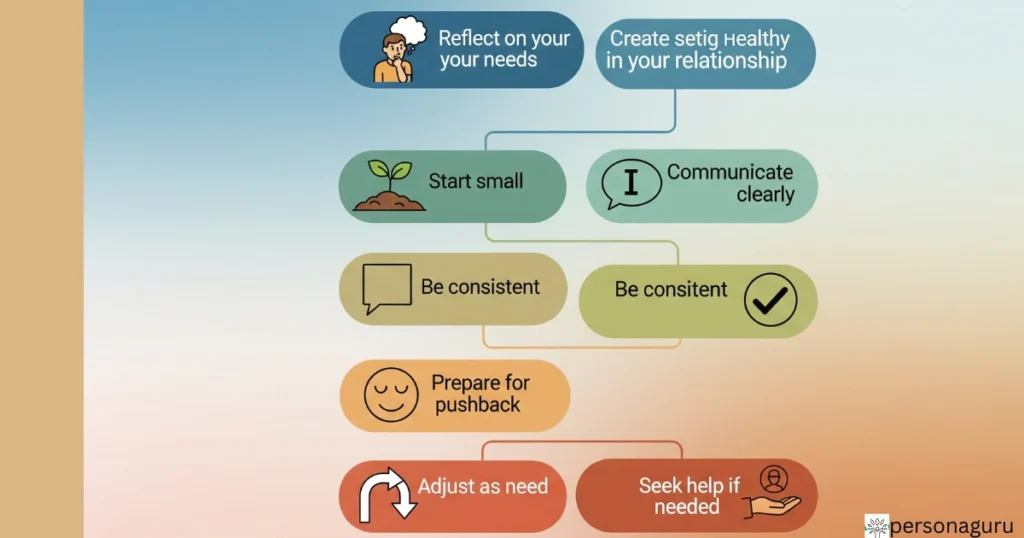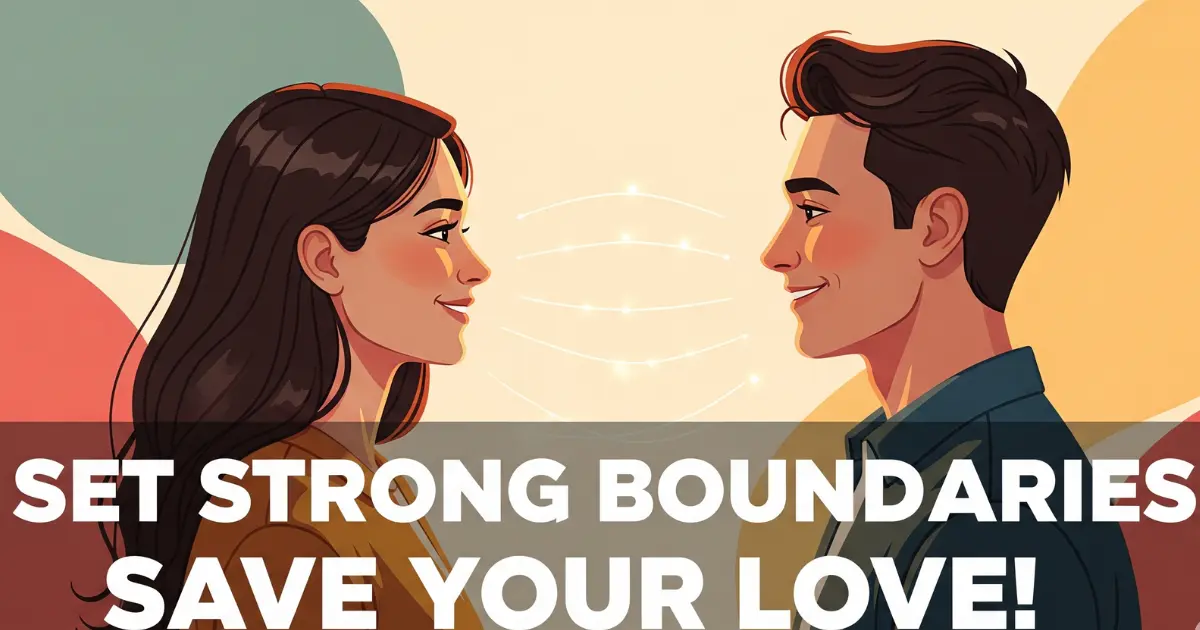Sometimes, feeling tired, ignored, or hurt in a relationship happens because boundaries aren’t clear.
Boundaries are like invisible lines that protect your well-being while strengthening trust and respect. These examples of boundaries in a relationship show that love is not about losing yourself but finding balance between caring for your partner and respecting your individuality.
As researcher Dr. Brené Brown says: “Daring to set boundaries is about having the courage to love ourselves, even when we risk disappointing others.”

What Are Boundaries in a Relationship?
Boundaries in relationships are personal limits that define which behaviors are acceptable and which are not. They safeguard your emotional, physical, and mental space—while giving love room to grow.
Types of boundaries include:
- Physical boundaries → personal space, touch, and consent
- Emotional boundaries → handling feelings with respect
- Time boundaries → balancing time together and apart
- Digital boundaries → social media, DMs, privacy
- Financial boundaries → money, spending habits, independence
- Communication boundaries → respectful discussions and conflict management
- Sexual boundaries → intimacy limits and comfort levels
- Family & social boundaries → relatives, in-laws, and friends
Why Are Boundaries in Relationships Important?
Boundaries are essential for relationship health. Here’s why:
- Protect mental health → lowers anxiety, depression & burnout
- Boost self-respect → people with clear boundaries have higher self-esteem (APA, 2023)
- Foster mutual respect → each partner feels valued
- Prevent resentment → avoids small annoyances building into bigger problems
- Support authenticity → you can be your true self without fear
- Strengthen relationship satisfaction → boundaries are linked to longer-lasting, happier partnerships
💡 As therapist Esther Perel says:
“When boundaries are clear, love has more space to grow.”
30+ Examples of Boundaries in a Relationship
Here are practical real-life boundary examples you can use right away:
Emotional Boundaries
- “I need space after work to recharge.”
- “I can’t be available for every crisis—let’s talk when I’m in a good headspace.”
- No yelling, insults, or name-calling during arguments.
- Respecting each other’s feelings even when disagreeing.
- “I am not responsible for your happiness; I can support you, but your emotions are yours.”
Communication Boundaries
- Listening without interrupting.
- No bringing up past mistakes repeatedly.
- Using “I” statements instead of blame.
- Agreeing not to argue in front of family/friends.
- “If you raise your voice, I’ll pause the conversation until we’re calm.”
Digital Boundaries
- Not checking each other’s phones without permission.
- Deciding together what to post on social media.
- Asking before tagging or posting couple photos.
- Limiting phone use during date nights.
- Respecting privacy in DMs, emails, and online activity.
Physical & Sexual Boundaries
- Respecting comfort levels with PDA.
- Always asking for consent before intimacy.
- Allowing personal space in the home.
- Respecting if one partner isn’t in the mood.
- “Let’s openly discuss what intimacy we’re both comfortable with.”
Financial Boundaries
- Agreeing on how to split bills.
- Transparency about debts/spending.
- Setting savings or budget goals together.
- Respecting independent spending habits.
- “I can’t loan you money—let’s find another solution.”
Time & Lifestyle Boundaries
- Scheduling personal time for hobbies/self-care.
- Making time for family & friends separately.
- Having tech-free quality time.
- Setting limits on late-night arguments.
- Regularly planning date nights to nurture the bond.
Family & Social Boundaries
- Deciding together how often to see relatives.
- Keeping relationship issues private from family gossip.
- “I won’t tolerate insults from family members—you need to support me.”
- Not forcing close ties with each other’s families.
- Respecting friendships outside the relationship.
How to Create and Set Boundaries in a Relationship
- Reflect on your needs → What stresses or drains you?
- Start small → Introduce one or two boundaries first.
- Communicate clearly → Use “I” statements like “I need…”
- Be consistent → Stick to your boundaries respectfully.
- Prepare for pushback → Stay calm if your partner resists.
- Adjust as needed → Boundaries evolve with time.
- Seek help if needed → Therapists can guide challenging talks.

Key Takeaways
- Setting examples of boundaries in a relationship is about respect, not control.
- Boundaries protect mental health, self-respect, and trust.
- There are many types: emotional, physical, financial, digital, and social.
- Open, consistent communication makes boundaries work.
- Healthy boundaries grow as your relationship evolves.
Quotes to Remember
- “Boundaries are what’s okay and what’s not okay.” — Brené Brown
- “Boundaries create safety, and safety allows intimacy to deepen.” — Esther Perel
- “Boundaries are not abandonment; they are protection.” — Relationship Expert, 2025
Final Thoughts
These examples of boundaries in a relationship prove that setting limits is not about building walls—it’s about building bridges. Boundaries invite respect, deepen intimacy, and help love last.
Remember: Boundaries are acts of love—for yourself and your partner.
Which of these examples of boundaries in a relationship stood out to you the most? Share in the comments and start setting one new boundary this week to strengthen your relationship. 💕
FAQs
What are some examples of boundaries in a relationship?
Examples include giving personal space, respecting privacy, not checking phones without consent, deciding how to share expenses, and speaking respectfully during arguments. These healthy boundaries build trust and prevent conflicts.
Why are boundaries important in a relationship?
Boundaries are important because they protect your mental health, reduce misunderstandings, and build respect between partners. Clear boundaries help couples feel safe, valued, and more satisfied in their relationship.
How can I set healthy boundaries in a relationship?
Start with small, clear statements like “I need some alone time after work.” Use calm communication, respect each other’s comfort levels, and stay consistent. Healthy boundaries are about clarity, not control.
What are unhealthy boundaries in a relationship?
Unhealthy boundaries include controlling your partner, ignoring consent, constant criticism, invading privacy, or never allowing independence. These behaviors create imbalance and damage trust in the relationship.
Can boundaries in a relationship change over time?
Yes, boundaries often change as relationships grow. In the beginning, partners may want more closeness, while later they may need more independence. Regular check-ins ensure both partners remain comfortable.

